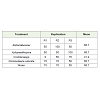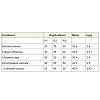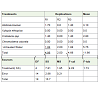Research Article
Effectiveness of Organic Control ofBiodeterioration of Yam Tubers in Storage Using Plant Extract (Alstonia boonei, Xylopia aethopica, Crotolaria spp, Chromoleana odorata) AgainstFarmers Post Harvest Crop Loss
Aghale, Duke Nduka1*, Umeh, Ogechi J2, Okorocha Adaugo3
1,2Michael Okpara University of Agriculture, Umudike, Nigeria
3National Root Crop Research Institute, Umudike, Nigeria
Corresponding author: Aghale, Duke Nduka, Michael Okpara University of Agriculture, Umudike, Nigeria, Tel No:08134005735; E-mail: aghalenduka@yahoo.com
Citation: Nduka AD, Ogechi UJ, Adaugo O. Effectiveness of Organic Control of Biodeterioration of Yam Tubers in Storage Using Plant Extract (Alstonia boonei, Xylopia aethopica, Crotolaria spp, Chromoleana odorata) Against Farmers Post Harvest Crop Loss. J Plant Sci Res. 2016;3(1): 147.
Copyright © 2016 Aghale, Duke Nduka, et al. This is an open access article distributed under the Creative Commons Attribution License, which permits unrestricted use, distribution, and reproduction in any medium, provided the original work is properly cited.
Journal of Plant Science & Research | ISSN: 2349-2805 | Volume: 3, Issue: 1
Submission: 07/04/2016; Accepted: 21/04/2016; Published: 01/05/2016
Abstract
Organic leaf extracts of four plants (Alstonia boonei De Wild, Chromolaena odorata Lam, Crotolaria retusa Linn, and Xylopia aethiopica) were assessed for their effectiveness in the control of biodeterioration of yam tubers in storage. The root knot (40%) infested yam tubers were dipped in the various organic leaf plant acetone extracts for 24 hours and assessed for 6 weeks on sprout inhibition, 8 weeks for sprouting inducement and 12 weeks for biodeterioration in storage. The results indicated that there was no significant difference (P>0.05) among the treatments and control on inhibition of yam tuber sprout. However,there were significant differences (P< 0.05) among the treatments as regards the inducement of sprouting. Xylopia aethiopica (43.4) and Chromolena odorata (42.4) extracts significantly (P< 0.05) stimulated yam tuber sprouting potentials and also controlled yam tuber iodeterioration in storage. Chromolaena odorata (0.00) and Xylopia aethiopica (0.00) best inhibited the yam biodeterioration activities in 12 weeks of storage as there were significant differences(P< 0.05) among the treatment means of Crotoleria spp, Alstonia boonei, and the control. The organic leaf extracts can evidiently be used for effective prevention of biodeterioration of yam tubers in storage, the study therefore recommend wide spread use by farmers.
Keywords: Yam tubers; Organic leaf extract; Biodeterioration in storage
Introduction
Productivity of crops grown for human consumption is at riskdue to the incidence of pests, especially weeds, pathogens and animalpests. Crop losses due to these harmful organisms can be substantialand may be prevented, or reduced, by sustainable crop protectionmeasures. Organic control measures offer a sustainable solution tomany environmental and food security problems in sub-Saharan Africa and world over. It uses fertilizers and pesticides (which includeherbicides, insecticides and fungicides) if they are considered natural(such as plant extracts, bone meal from animals or pyrethrin fromflowers), but it excludes or strictly limits the use of various methods(including synthetic petrochemical fertilizers and pesticides; plantgrowth regulators such as hormones; antibiotic use in livestock;genetically modified organisms [1]. Storage Crop loss has been the bane of arable crop farmers in Nigeria and effective plant protection strategies has replicated their frequently asked questions during extension service sessions hence this study.
Most uncultivated ethno-medicinal tropical plants with biopesticidalpotentials are yet to be investigated and exploited for thepurpose of organic plant protection. The use of plant protectionchemicals to a larger extent is not only very expensive, it possesses toxic and poses potential hazards to man and environment among others[2]. There is need for alternative organic control of biodeteriorationof arable crops such as cassava and yam tubers in storage using plantextracts.
Yams (Dioscorea rotundata) and cassava (Manihot esculenta,Crant) contribute about 80% of the food calories in West Africa andyam alone accounts for 60% of this total. Yam is to West Africa aswhat potatoes is to Europeans and occupies important position inthe economic and social life of Nigerians in which about 1.5 millionmetric tons are produced annually [3].
The root knot nematodes [4] (Meloidogyne spp) have beenidentified as the most economic pest of yam in Nigerian with anincidence range of 25-30% in major yam producing areas [5]. The rootknot nematodes damage yam tissues by their feeding on the tubersand also create micro wounds through which secondary pathogens(fungi, bacteria and viruses) can enter and cause complete decay.Infestation of root knot nematodes on stored yam tubers resultedinto complete deterioration due to subsequent attack of fungi andbacteria and was reported to contribute greatly to post- harvest biodeterioration with consequent losses in monetary terms [6].
Onyenobi reported in a survey on pesticide use and misuse inNigeria that 60% of local farmers use Aldrex T to protect their seedyam setts at planting and that Aldrex T is a combination of 250g/kg, Aldrin (a cyclodiene insecticide) and thiram (a fungicide at200g/kg) [7]. Aldrex or soildrin is the trade name for Aldrin. TheInternational Register of Potentially Toxic Chemicals (IRPTC) ofUnited Nations Environmental Program (UNEP) listed Aldrin as oneof the chemicals banned or severely stricted in several countries [8].The organochlorine have been reported to be deleterious to man andhis environment due to their persistence in crops, bioaccumulation insoil and within the fatty tissue of human reproductive systems.
This investigation was designed to screen the organic pesticidalpotentials of four plants (Alstonia boonei De Wild, Chromolaenaodorata Lam, Crotolaria retusa Linn, and Xylopia aethiopica) in thecontrol of bio-deterioration in yam at storage and also on their effectsin the inhibition and stimulation of the sprouting potentials of yamtubers in storage. Passam reported that the ability of yam tubers togerminate after variable and often prlong periods of dormancy is avital quality characteristic which could be manipulated to improvethe flexibility of storage duration and date of planning [9]. A longdormant period, without loss of viability, enables the tubers tobe used in propagation and is a factor in the perenniality of yams.If sprouting could be delayed by prolong dormancy, a longer shelflife of healthy yam tubers could be achieved. The plants used in thisresearch were readily available, affordable, and non-toxic to man andhis environment also contain natural products that have been provedeffective in the treatment of various diseases by the natives.
The need for organic based pesticides that could be used in placeof these synthetic chemicals which are also environmentally friendlyfor the protection of yam tubers in storage against bio- deteriorationhas given impetus for this trials.
Materials and Methods
The investigation was conducted at the Nematological laboratoryof Abia State University Uturu, Nigeria. The yam tubers used weighed(100± 5g) and was slightly infested,(using gall index (GI) of 2 for(21-40%) galled root-knot nematode, scale of 0-5=0 (no infection), 1=1-20% of tuber galled, 2 = 21-40% of tuber galled, 3 = 41-60%tubergalled, 4= 61-80% and 5= 81-100% of tuber galled. The 40% surfacearea covered tubers with phytonematode visually classified weregrouped in three replicates of four each (12 yam tubers) for eachtreatment with each natural product, and the control (untreatedinfested control) [10].
The ethnomedicinal plants used were Alstonia boonei, Xylopiaaethopica, Crotolaria spp, Chromoleana odorata and the untreatedcontrol. The healthy harvested leaves were dried at room temperaturein the laboratory for three weeks and pulverized (ground into powderwith an electrically powered Warring blender). One gram of thepowdered dust of each sample was soaked in 10ml acetone in a glassspecimen bottle for one week to extract the active ingredients. Thiswas filtered and the solvent was allowed to evaporate within threedays outside the laboratory. Each extract was dissolved in 1000cmwater (acetone extract of 1g/L of water [11]. Each group of seed yamsets were soaked in each plant extract solution and the control yamtubers also soaked in water for 24 hours. The soaked yam seeds werelaid out on benches at room temperature and relative humidity rangeof 75 to 90%. The treatments were monitored weekly and data werecollected on the 6th week for inhibition, 8 week for sprouting and at 12week for biodeterioration (growth of fungi and number of rotted seedyams). The data generated was transformed into logarithmic functionbefore the computation of the analysis of variance.
Results and Discussion
Table 1 shows the mean and confidence limits in respect of thepercentage of sprout inhibited seed yams at the end of 6 weeks instorage, Crotoleria retusa extract fairly inhibited seed yam sproutingpotentials (49.1) when compare with other plant extracts, thoughwithout statistical difference (P> 0.05). The indication was that theapplication of extract from Crotoleria retusa inhibited sprouting higher than the other treatments. Table 2, shows the effect of organic extracts on the percentage of sprouted seed yams at 8 weeks instorage. Xylopia aethiopica (43.4) and Chromolena odorata (42.4)extract significantly (P< 0.05) stimulated yam tuber sproutingpotentials. However, there was significant differences (P< 0.05)among the treatments as regards the inducement of sprouting.It appears that the different inoculum levels did not significantlydetermine the sprouting ability of the yam tubers, but resulted intosignificant differences (P< 0.05) among the active ingredients of theplant extracts and the control. Yam tuber infestation by nematodesdestroy the germinative cells and subsequently reduced the sproutingpotentials, but Onyenobi reported that slight nematode infestationstimulate sprouting and the yam tubers used in the investigationwere slightly infested with root knot nematode (40% coverage withnematodes) [12]. And there were no significant differences (P>0.05)in the inhibition of the sprouting potentials of the yam tubers by thetreatments due to the low level of nematode infestation on the tubers.
Table 2: Shows the effect of organic extracts on the percentage of sprouted seed yams at 8weeks in storage.
Table 3 indicates that Chromolaena odorata (0.00) and Xylopia aethiopica (0.00) best inhibited the yam biodeterioration activities in 12 weeks of storage as there were significant differences (P< 0.05) among the treatment means of Crotoleria spp, Alstonia booneiand the control. The rot organism reported to associate with yam deterioration are fungi , bacteria and viruses and Adesiyan reportedthat synergistic relationship between these plant pathogenic organismand nematodes increase the severity of the yam rot [13]. It is howeveraccepted that plant parasitic nematodes create micro wounds onthe tubers thus facilitating entry of other pathogens, the nematodesproduce the enzyme amylase which hydrolyse the starch into sugarthat provide an ideal medium for microbial attack [13,14]. The plants(Xylopia and Chromolaena odorata ) do possess strong biopesticidalpotentials and also do not have adverse effect on the viability of theseed yams. It could therefore be used for the protection of yam biodeterioration before planting and on storage.
Conclusion
Yam nematodes regarded as primary pathogens in yam tuberdeterioration cause decay or necrosis of the tissue and also make theinfected tubers more prone to fungi and bacteria attack. Nematodesattack gives rise to dry rot while fungal and bacteria attack gives riseto wet rot [10]. Studies on nematode infected yam tubers show thatthere is a biochemical conversion of starch to simple sugar induced bythe nematode and these inter- conversion processes affect the storageof the tuber adversely. In the presence of the simple sugar, fungiand bacteria grow actively and their activities result in progressivedeterioration of the tuber.
The effect of the organic extracts on nematodes (Meloidogyneincognita) infected yam tubers indicated that the different plantextracts and the control did not stastistically differ significantly intheir efficacy in the inhibition of yam sprout at 6 weeks in storage.The results from the biodeterioration revealed that Xylopia andChromolaena odorata effectively controlled the biodeteriorations ofyam tubers based on the assumption that rot organisms (fungi andbacteria) are neccessarially the major cause of biodeterioration instorage and not high temperature.
The intensification of crop production necessary to meet theincreasing demand through enhanced productivity per unit areamight be impossible without a concomitant intensification of pest/disease control. The application of organic principles inpest/diseasecontrol enables the employment of local resources and thereforecost-effective. It contributes to ecologically sustainable and socioeconomic development. Therefore the technique should be inculcatedto the farmers through extension services package delivery (On-FarmAdaptive Research (OFAR) for wide spead farmer’s use.
References
- Umeh OJ, Ekwe KC (2012) Evaluating farmers’ use of mucunautilis life mulch for biological control of guinea grass (Panicum maximum) in cassava/mucuna intercrop. Proceedings of 5th Annual conference of Nigeria society of indigenous knowledge and development (NSIKAD).
- Aghale DN (2011) Evaluation of Botanicals in the control of Root Knot nematode M. incognita (Kofoid& Whitehead, 1919) Chitwood, 1949 in yam production. Ph.D Thesis, Dept of Crop Production/Protection, Abia StateUniversity, Uturu, Nigeria.
- FAO (2003) FAO year book, Rome Italy.
- Chitwood BG (1949) Root knot nematodes part 1. A revision of the genus Meloidogyne Goeldi, 1887. Proc. Helminth Soc. Washington 16: 90-104.
- Aghale DN, Umeh OJ, Anyim A (2016) Effect of Leaf Powder Treatment on Root-Knot Nematode (Meloidogyne incognita) and Proximate Composition of Yam Tubers; Implication on Food Security. J Plant Sci Res 3: 1-4.
- Nwauzor EC (1982) Identification, Biology and Control of Root knot nematodes M. incognita on edible yams (D. rotundata). Ph.D thesis of the University of Ibadan. 234pp.
- Onyenobi FI (1992) Root knot nematode; An Economic problem in yam production in Nigeria. The Biology and Control of nematode pest of food crops in Africa. Ed.Fawole et al., published by Hiswill information Research Management Ltd, Ibadan Nigeria (1992). Pp37-48.
- IRPTC (1994) Progress on implementation of the FAO/UNEP joint program consent of the International Register of Potentially Toxic Chemicals devoted to information on hazardous chemicals. 12: 8.
- Onyenobi FI (1996) Pesticide use and misuse in Nigeria. 40pp. published by Fasmen communications, Okigwe, Nigeria ISBN 978-2986-02-x.
- Adesiyan SO, Caveness FE, Adeniji MO, Fawole B (2000) Nematode Pest of Tropical Crops. Pp 114.
- Passam HC (1982) Dormancy of yam in relation to storage. Clarendon Press, Oxford. Pp285-293.
- Onyenobi FI (1986) Chemical control of Meloidogyne spp in yam production in yam (Dioscorea rotundata poir) Production. Ph.D thesis of the University of London, Imperial College 262pp.
- Adesiyan SO (1975) Studies on the infection of yam by Scutellonemabradys (Steiner and Lellew) Ph.D Thesis of the University of Ibadan, 299pp.
- Salawu EO (1992) Prelimary studies on the effectiveness of some medicinal plant extracts as inhibitors of egg hatch in Heterodara in Nigeria. The biology and control of nematode pest of food crops in Africa. Pp193-195.



